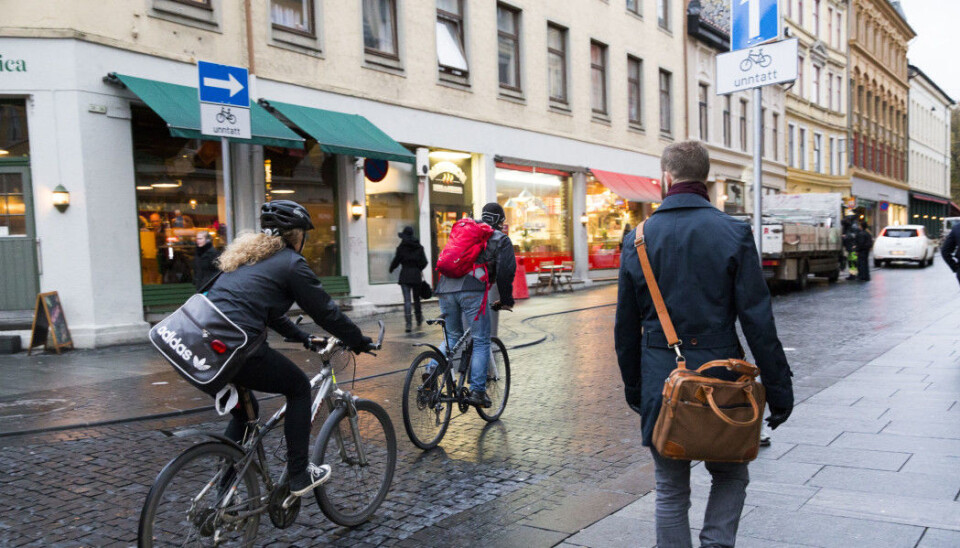
Cyclists and long waiting times at traffic lights discourage pedestrians
Walking is good for people and the environment. So how do cities encourage people to walk more?
Norway’s capital, Oslo, doesn’t just want more cyclists in the city, they also want more pedestrians.
But mixing cyclists and pedestrians can be a bad idea. In fact, a high percentage of bicycle accidents occur between pedestrians and cyclists.
So, what does it take to make cities to be more pedestrian-friendly? Researchers from the Norwegian Institute of Transport Economics (TØI) have now examined this exact question and have some answers.
Bicycles rule in Oslo
Oslo has already invested a great deal of time and money into becoming a bicycle-friendly place. In recent years, the city has built an increasing number of bicycle paths and roads, installed separate traffic lights for cyclists, provided urban bicycles and most recently, electric scooters for hire.

The TØI researchers point out, however, that pedestrians are also good for cities and that more should be done to encourage them.
“When more people walk, it helps reduce car use and emissions, improves people’s health, makes for pleasant and more vibrant cities, increased social interaction and strengthens public transport's competitiveness,” the TØI researcher wrote in a press release about their findings.
The new TØI report is a summary of previous research from all over Europe on pedestrians in cities.
Cyclists vs. pedestrians
The research summary found, not surprisingly, that the safer we think sidewalks are, the more we use them.
Why? Well, it’s not always safe to be a pedestrian. Thousands of people are injured annually in what are called single accidents, which is when no other individuals are involved, a different report from last year shows.
Sidewalks have to be wide, ploughed clear of snow and gritted if they’re icy, and fairly clean and with no holes to encourage people to walk.
And they should preferably be free of cyclists, at least according to a 2013 survey of residents in Kristiansand. These residents said that separate paths for pedestrians and cyclists were one of the five most important measures that would make neighborhoods more attractive to walk in.
This has been confirmed by other surveys, where people suggest cyclists should have their own lanes or cycle paths. Survey respondents also suggested a ban on cycling on sidewalks.
Cyclists should be in the road
“Many of the challenges that arise when different users are mixed in the streets can probably be solved with new bicycle lanes and other measures. But these are very expensive solutions,” says Professor Aksel Tjora.
"Other cities have addressed this issue by requiring cyclists to share the roadway with cars, and I think this is the way to go," he says.
Tjora is a professor of sociology at NTNU and has studied how societies develop and what happens when people encounter each other, including in traffic.
He thinks that cycling on the road will slow motorists down and force them to be more attentive. Cyclists should consequently assume that they belong in the roadway.
“As a cyclist, you’re interested in efficiency, in which case, it’s almost always best to behave as a motorist. The challenge here is the transition period, and how many cyclists will find it scary to cycle among cars and buses,” he says.
“But I have cycled in a part of Melbourne, Australia, where cyclists aren’t allowed on sidewalks and where cyclists have to ride among cars, even in roads with three to four lanes in each direction,” he said.
Avoid expensive solutions
In most cities, and especially in Oslo, politicians want city centres to be car-free.
"Since we are now working to reduce car traffic over the long term, it doesn’t make sense to build expensive solutions that work today, but which may prove unnecessary in ten years," Tjora says, such as separate bike paths with traffic lights.
Instead, he suggests a strictly enforced 30 kph speed limit throughout the city, a ban on biking on sidewalks, free bikes for all children to introduce bicycles as "something you just do" and separate bus lanes where possible.
Long wait times at traffic lights a problem
But cyclists aren’t the only challenge. People get frustrated if they have to wait a long time to cross the street, the TØI researchers found.
Additionally, zebra-striped pedestrian crosswalks should include both signage and other markings to make pedestrians to feel safe. And it turns out that traffic islands that divide crosswalks into two make pedestrians more confident about crossing the street.
----------































